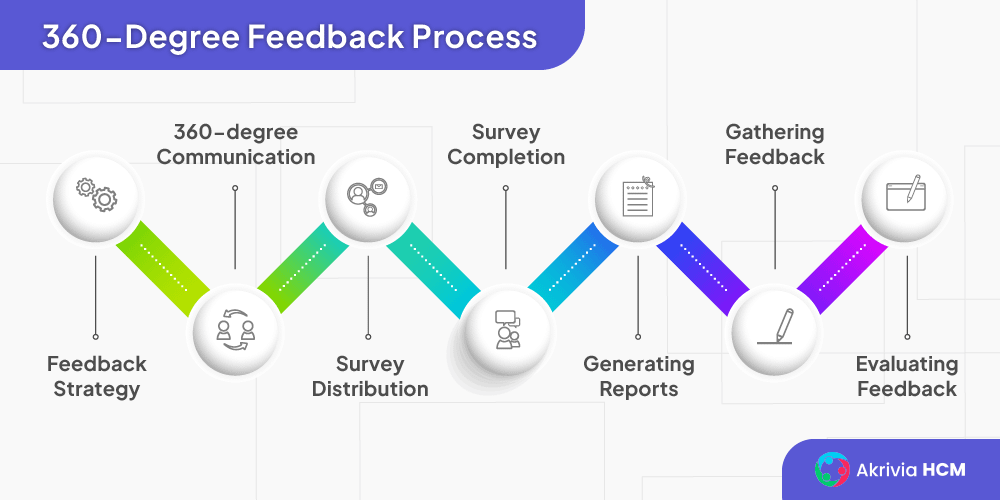Table of Contents
A method of getting an unbiased review from the workforce about an employee’s behaviour, strengths, weaknesses, and more by using a set of questions or an anonymous survey is known as 360-degree feedback. The survey includes questions measured on a rating scale. Organizations use the 360-feedback system to help managers and leaders identify their strengths and weaknesses. The automatic tabulation of results and a format that allows the recipient to create a development plan make this system effective.
When properly implemented, it can be a highly effective tool for performance development. The anonymous feedback process allows people to provide honest input about their co-workers’ performance that they might reluctant to share. Recipients get to know what they should work on and how they might adjust their behaviours and skills to perform better at their jobs.

Organizations attempt to help their employees grow by providing them with performance evaluations, but traditional evaluation methods are flawed. 360-degree feedback is a better way of getting helpful feedback because it allows each individual to get feedback from their boss, peers, and customers. Most 360-degree feedback tools also will enable each individual to respond on their behalf.
When organizations introduce and use multi-rater feedback processes such as 360-degree assessments, they often struggle to do so effectively. But, with the proper steps, they can improve how they introduce and use these processes and maximize their value. Changing performance feedback methods can be contentious, especially when they determine an employee’s compensation.
360-degree feedback allows each employee to understand how he’s viewed by his coworkers and managers. The best kinds provide inputs based on observable behaviors. The feedback tells you what skills and behaviors the organization wants to see you demonstrate to accomplish the mission, vision, goals, and live values. The input is firmly rooted in customer satisfaction. Employees often have a say in who will be their feedback provider and choose people they interact with regularly.
The level of detail in feedback can vary from person to person, but it’s important to get balanced insights between too much effort and little effort. For example, if your manager told you how they felt you were doing, what they thought of your work ethic and how it could be improved and gave suggestions on how to complete your next task more efficiently. And if a peer reviewer said that a worker was friendly and always completed their portion of the project by their deadline, they would probably be considered an expert in giving constructive criticism.
It provides constructive criticism and guidance to employees for improving their performance. It gives valuable insights related to the individual’s work and areas of improvement. The feedback is designed to help the employee improve performance and move up the corporate ladder.
For an effective 360-degree feedback process to be carried out, the following steps must be taken:

Every company follows a different framework for the 360-degree feedback process, but these are the critical steps that everyone considers. Let’s take a look at the steps:
Before starting the entire process, everyone should follow a plan and work accordingly. The feedback strategy must include the number of people from whom you will get the feedback, the set of questions you will ask, and the distribution chain.
Clearly, the chief executives and board members must be aware of the feedback process. It does not only mean that you have to inform them; you must do the all-around communication about the process.
It is one of the most important steps you should manage on a priority basis because all the results depend on it. The HR managers are responsible for managing the survey chain, which should be circulated within a decided period.
To complete the survey, reviewers should examine the employee’s performance in terms of several factors. To ensure timely submission of completed forms, a deadline should be set by which reviewers must submit these forms to HR.
After surveys are completed, they are reviewed to prepare performance reports on each employee. These reports provide details about everyone’s skills, strengths, weaknesses, and improvement areas. A 360-degree feedback system can produce such reports in a timely manner.
According to the Organization’s plan, employees can expect to receive their survey results in one of three ways: by mail, at a performance appraisal meeting, or via phone call. The feedback itself takes up to two or three hours per employee and should be delivered in person.
Re-evaluating the feedback for every employee is a bit tough work, but it will be beneficial for the upcoming years and also helps them to build a career path.
The 360-degree process is a self-assessment by the individual and a feedback session with their peers. The personality or style assessments are similar to the 360 degrees in that they involve feedback. Still, the difference is that the 360 improves an individual’s performance, whereas the personality or style assessments are used for something else.
A 360-degree feedback survey is an answer to the effective management of an organization. Giving and receiving feedback helps cut across hierarchal barriers to improving the employees’ effectiveness, efficiency, and productivity level.
Evaluating your employees’ performance can be a difficult procedure, but it can also motivate employees to produce better results. A positive evaluation process can have a positive effect on your career and that of your staff members. 360-feedback can be that process to review employee performance and determine what changes if any, are needed in the future. It can help to ensure that your employees know what is expected of them and can determine whether or not they are meeting their goals. But getting results is not enough for performance betterment because upskilling and changing behaviour depends on the employee.
Let’s Recruit, Reward, and Retain
your workforce together!
